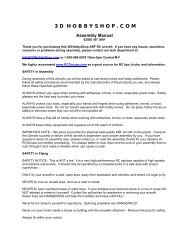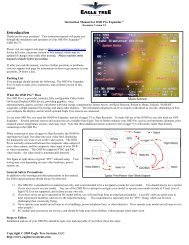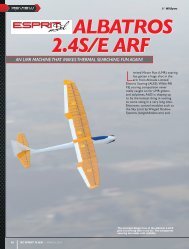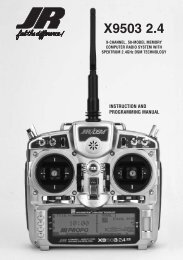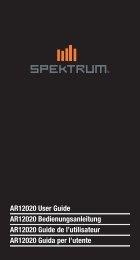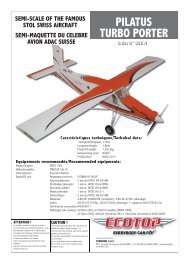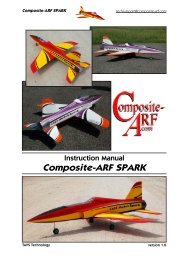Create successful ePaper yourself
Turn your PDF publications into a flip-book with our unique Google optimized e-Paper software.
FReQUeNTLy ASkeD QUeSTIONS<br />
ON SPEKTRUM 2.4GHz<br />
Your DSM2 equipped 2.4GHz system is intuitive to operate, functioning<br />
nearly identically to FM systems. Following are a few common questions from<br />
customers:<br />
Q: After I’ve bound the receiver to my transmitter, which do I turn<br />
on first when I want to fly?<br />
A: Either one. Every DSM 2.4GHz transmitter has a GUID (Globally Unique<br />
Identifier) code imbedded in its signal. When you bind a DSM receiver<br />
to your transmitter, this GUID code is stored in the receiver. If you turn<br />
the receiver on before the transmitter, you don’t have to worry about it<br />
responding to another transmitter. The receiver will inhibit throttle output<br />
and drive all controls to preset positions while it waits for a signal from the<br />
transmitter with the same GUID code it has stored.<br />
If a DSM transmitter is turned on first you can expect it to connect within 6<br />
seconds of powering on the receiver.<br />
Q: Sometimes the system takes longer to connect or doesn’t<br />
connect at all. Why?<br />
A: In order for a DSM system to connect, the receiver must receive a large<br />
number of uninterrupted signal packets from the transmitter. This process<br />
takes just a few seconds, but if the transmitter is too close to the receiver<br />
(within 4 feet) or near metal objects it may detect its own reflected 2.4GHz<br />
energy as “noise”. This can delay or prevent connection.<br />
If this happens make sure you are a sufficient distance from metal objects<br />
and the receiver itself before you power up and try again.<br />
Q: Is it true that DSM systems are less tolerant of low voltage?<br />
A: All DSM receivers require at least 3.5V to operate normally. Most servos<br />
cease to operate below 3.8V. Using multiple high-voltage servos, however,<br />
with an inadequate power supply can allow voltage to momentarily drop<br />
below 3.5V. This will cause the receiver to “brown out” and reconnect.<br />
All recently manufactured <strong>JR</strong> and Spektrum DSM receivers feature<br />
QuickConnect technology that will reconnect the system within a quarter of<br />
a second should a brownout occur. In addition, the receiver’s LED will flash,<br />
indicating a brownout has occurred. If after landing you notice your DSM<br />
receiver’s LED is flashing, make sure you have adequate power before you<br />
fly again.<br />
Q: Sometimes when I power on my DSM system I notice the<br />
receiver won’t connect and it needs to be rebound to the<br />
transmitter. Can this happen in flight?<br />
A: No. A DSM receiver cannot be unbound from its transmitter without specific<br />
action by the user.<br />
You can accidentally unbind a receiver by inadvertently pressing the bind<br />
button on your transmitter when you turn it on. This causes the transmitter<br />
to go into bind mode. If this happens and the transmitter doesn’t detect a<br />
binding signal from the receiver it can cause the receiver to be unbound.<br />
Some transmitter stands can cause the bind button to be depressed during<br />
power up, but these instances are extremely rare.<br />
If your system fails to connect, chances are much greater that it’s the result<br />
of one of the following conditions and not because the receiver is unbound.<br />
1. You’ve selected the wrong model memory.<br />
2. The transmitter is too close to conductive material to connect<br />
(see FAQ #2).<br />
Q: How important is it that I test my system using a Spektrum<br />
flight Log?<br />
A: All 2.4GHz signals, not just DSM, are affected by proximity to conductive<br />
materials such as carbon fiber or metal. Few RTF and ARF sport airplanes<br />
or helicopters use enough of these kinds of materials for it to be an issue.<br />
If, however, you’re flying a sophisticated model that uses a lot of conductive<br />
materials in its construction, a Flight Log can be helpful. The information it<br />
collects when you fly will help you determine the optimum location for your<br />
receiver(s) so you can minimize the effects of these materials on your signal<br />
performance. For more details on the Flight Log and how it works, visit<br />
SpektrumRC.com.<br />
GENERAL INfORMATION<br />
Servo Precautions<br />
• Do not lubricate servo gears or motors.<br />
• Do not overload retract servos during retracted or extended conditions. Make<br />
sure they are able to travel their full deflection. Overloading or stalling a<br />
servo can cause excessive current drain.<br />
• Make sure all servos move freely through their rotations and no linkages<br />
hang up or bind. A binding control linkage can cause a servo to draw<br />
excessive current. A stalled servo can drain a battery pack in a matter of<br />
minutes.<br />
• Correct any control surface “buzz” or “flutter” as soon as it is noticed in<br />
flight, as this condition<br />
can destroy the feedback potentiometer in the servo. It may be extremely<br />
dangerous to ignore such “buzz” or “flutter.”<br />
• Use the supplied rubber grommets and brass servo eyelets when mounting<br />
your servos. Do not over-tighten the servo mounting screws, as this negates<br />
the dampening effect of the rubber grommets.<br />
• Ensure the servo horn is securely fastened to the servo. Use only the servo<br />
arm screws provided; the size is different from other manufacturers.<br />
• Discontinue to use servo arms when they become “yellowed” or discolored.<br />
Such servo arms may be brittle and can snap at any time, possibly causing<br />
the aircraft to crash.<br />
• Check all related mounting screws and linkages frequently. Aircraft often<br />
vibrate, causing linkages and screws to loosen.<br />
General Notes<br />
Radio controlled models are a great source of<br />
pleasure. Unfortunately, they can also pose a<br />
potential hazard if not operated and maintained<br />
properly.<br />
It is imperative to install your radio control<br />
system correctly. Additionally, your level of<br />
piloting competency must be high enough to<br />
ensure that you are able to control your aircraft<br />
under all conditions. If you are a newcomer to<br />
radio controlled flying, please seek help from an<br />
experienced pilot or your local hobby store.<br />
Safety, Precautions, and Warnings<br />
As the user of this product, you are solely<br />
responsible for operating it in a manner that does<br />
not endanger yourself and others or result in<br />
damage to the product or the property of others.<br />
Carefully follow the directions and warnings for<br />
this and any optional support equipment (chargers,<br />
rechargeable battery packs, etc.) that you use.<br />
This model is controlled by a radio signal that<br />
is subject to interference from many sources<br />
outside your control. This interference can cause<br />
momentary loss of control so it is necessary to<br />
always keep a safe distance in all directions around<br />
your model, as this margin will help to avoid<br />
collisions or injury.<br />
• Always operate your model in an open area away from cars, traffic, or<br />
people.<br />
• Avoid operating your model in the street where injury or damage can occur.<br />
• Never operate the model out into the street or populated areas for any<br />
reason.<br />
• Never operate your model with low transmitter batteries.<br />
• Carefully follow the directions and warnings for this and any optional<br />
support equipment (chargers, rechargeable battery packs, etc.) that you use.<br />
• Keep all chemicals, small parts and anything electrical out of the reach of<br />
children.<br />
• Moisture causes damage to electronics. Avoid water exposure to all<br />
equipment not specifically designed and protected for this purpose.<br />
Safety Do’s and Don’ts for Pilots<br />
• Ensure that your batteries have been properly charged prior to your initial<br />
flight.<br />
• Keep track of the time the system is turned on so you will know how long<br />
you can safely operate<br />
your system.<br />
• Perform a ground range check prior to the initial flight of the day. See the<br />
“Daily Flight Checks Section” for information.<br />
• Check all control surfaces prior to each takeoff.<br />
• Do not fly your model near spectators, parking areas or any other area that<br />
could result in injury to people or damage of property.<br />
• Do not fly during adverse weather conditions. Poor visibility can cause<br />
disorientation and loss of control of your aircraft. Strong winds can cause<br />
similar problems.<br />
• Do not point the transmitter antenna directly toward the model. The radiation<br />
pattern from the tip of the antenna is inherently low.<br />
• Do not take chances. If at any time during flight you observe any erratic or<br />
abnormal operation, land immediately and do not resume flight until the<br />
cause of the problem has been ascertained and corrected. Safety can never<br />
be taken lightly.<br />
Federal Aviation Administration<br />
38 <strong>JR</strong> <strong>11X</strong> • RADIO INSTRUCTION MANUAL <strong>JR</strong> <strong>11X</strong> • RADIO INSTRUCTION MANUAL<br />
39<br />
Purpose<br />
This advisory outlines safety standards for<br />
operations of model aircraft. We encourage<br />
voluntary compliance with these standards.<br />
Background<br />
Attention has been drawn to the increase in model<br />
aircraft operation. There is a need for added caution<br />
when operating free flight and radio controlled craft<br />
in order to avoid creating a noise nuisance or a<br />
potential hazard to full-scale aircraft and persons<br />
and/or property on the surface.<br />
Operating Standards<br />
<strong>Model</strong>ers generally are concerned with safety and<br />
exercise good judgment when flying model aircraft.<br />
However, in the interest of safer skies, we encourage<br />
operators of radio controlled and free flight models<br />
to comply with the following standards:



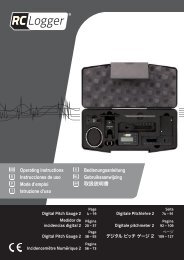
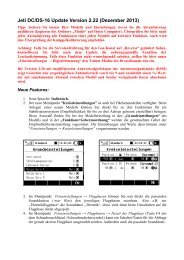

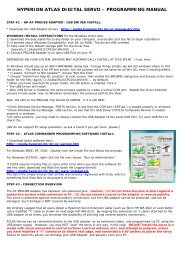
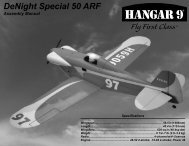
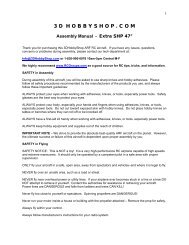
![P01(Oxalys EP) [更新済み].ai - Kyosho](https://img.yumpu.com/26948574/1/184x260/p01oxalys-ep-ai-kyosho.jpg?quality=85)
